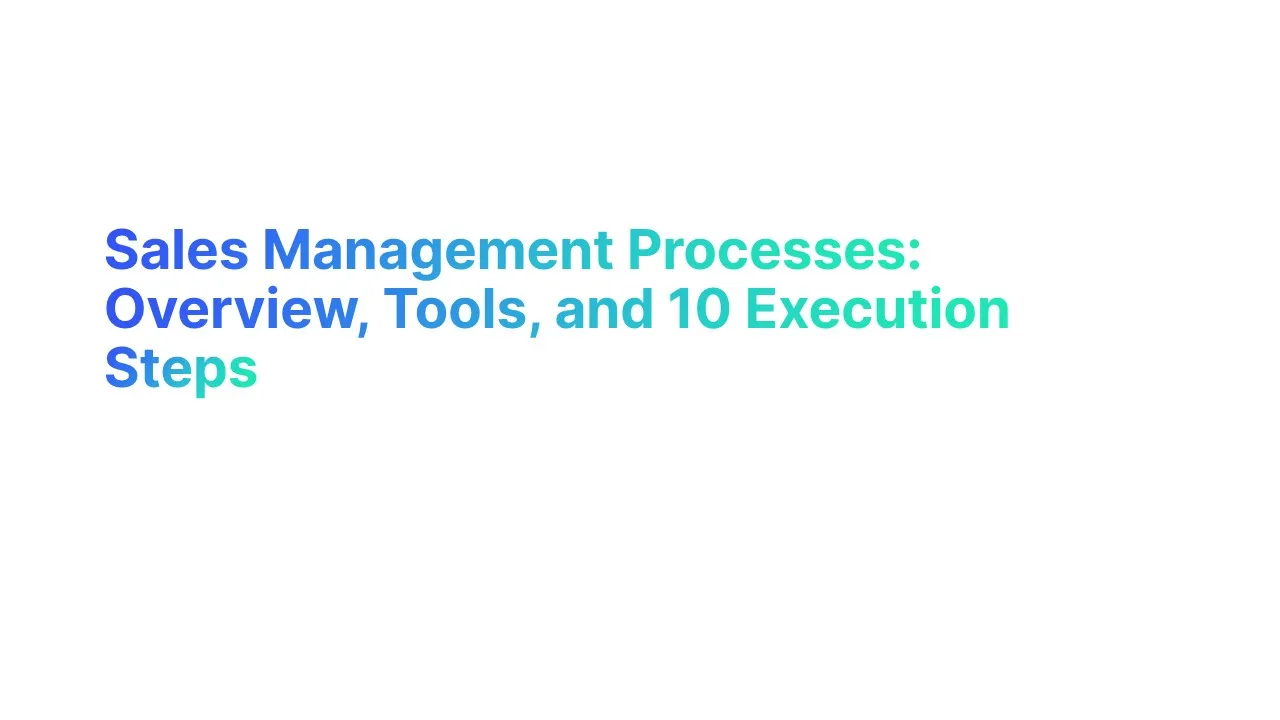Introduction to Sales Management

What is Sales Management?
Sales management is a critical business function that focuses on the practical application of sales techniques and the management of a firm's sales operations. It is aimed at achieving the sales targets of an organization effectively and efficiently while building a competitive sales team.
Sales management involves overseeing and guiding a sales team to achieve specific sales targets. It encompasses a variety of tasks including:
- Recruitment and Training: Building a capable sales team by selecting the right individuals and providing them with the necessary training to excel in their roles.
- Strategy Development: Crafting strategies that align with the company’s objectives and market dynamics.
- Performance Monitoring: Regularly assessing the performance of sales activities against the set goals.
Key Aspects of the Sales Management Process
The sales management process is a comprehensive approach designed to boost both efficiency and effectiveness across the sales team. Key aspects include:
Goal Setting: Establishing clear, measurable objectives for the sales team is fundamental. Companies that set specific sales targets see a 27.4% higher win rate on forecasted deals compared to those without clear goals.
- Resource Allocation: Determining how to best utilize the sales force and other resources to maximize sales outcomes.
- Territory Management: Assigning sales territories in a manner that optimizes coverage and minimizes overlap.
Sales Operations:
- Sales Forecasting: Using historical data and market analysis to predict future sales, which helps in planning and budgeting. Research indicates that companies with accurate sales forecasts are 10% more likely to grow their revenue year-over-year and 7.3% more likely to hit quota.
- Management of the Sales Pipeline: Monitoring the sales pipeline to ensure it is healthy and moving forward. This involves tracking the progress of various sales opportunities from initial contact to closing.
Performance Management:
- Monitoring and Evaluation: Regular assessments to ensure sales targets are being met and identifying areas for improvement.
- Feedback and Training: Providing ongoing training and feedback to sales representatives, which has been shown to improve sales performance by up to 20%.
Use of Sales Management Tools: Implementing tools such as CRM systems, sales analytics platforms, and performance tracking software to streamline operations and enhance productivity. For instance, companies using advanced CRM solutions have seen a sales increase by up to 29%.
Different Stages of the Sales Management Process

The sales management process encompasses several distinct stages that contribute to the overall effectiveness of a sales team and the achievement of an organization's sales objectives. Here's a breakdown of the different stages:
1. Sales Planning
This is the foundational stage where the overall sales strategy is crafted. Planning involves setting clear sales objectives based on market research and business goals. Key activities include:
- Identifying target markets and customer segments.
- Setting realistic sales targets.
- Allocating resources strategically.
2. Recruitment and Staffing
Building a capable sales team is crucial. This stage focuses on:
- Recruiting skilled sales personnel who align with the company’s values and sales objectives.
- Developing a structure for the sales team that optimizes coverage and efficiency.
3. Training and Development
To ensure the sales team is effective, ongoing training is essential. This stage involves:
- Providing initial training to new hires on product knowledge and sales techniques.
- Offering continuous development opportunities to keep the team updated with the latest market trends and sales strategies.
4. Sales Execution
This is the action stage where sales strategies are implemented. Sales execution involves:
- Engaging with customers and prospects.
- Negotiating deals and closing sales.
- Utilizing CRM systems to track interactions and manage customer relationships.
5. Monitoring and Evaluation
To gauge the effectiveness of the sales strategy, continuous monitoring is necessary. This includes:
- Tracking sales results against targets.
- Analyzing key performance indicators like sales volume, conversion rates, and customer acquisition costs.
- Adjusting sales strategies based on performance data and market feedback.
6. Motivation and Compensation
Keeping the sales team motivated is vital for sustained performance. This stage involves:
- Implementing incentive programs based on performance metrics.
- Offering non-monetary rewards and recognition for outstanding achievements.
7. Sales Analysis and Reporting
Insights gained from sales data are critical for making informed decisions. This stage includes:
- Regularly reviewing sales reports and dashboards.
- Conducting sales forecast reviews to anticipate market demands and adjust strategies accordingly.
8. Customer Feedback and Relationship Management
The sales process does not end with a transaction. Maintaining customer relationships is key. This stage focuses on:
- Gathering customer feedback to enhance product offerings and customer service.
- Developing loyalty programs to retain existing customers and attract new ones through referrals.
10 Strategies For an Effective Sales Management Process

Effective sales management is crucial for optimizing the performance of a sales team and ultimately driving the revenue growth of a company. Here are 10 detailed strategies to enhance the sales management process:
1. Implement a Structured Sales Process
Creating and maintaining a structured sales process is vital for consistency and efficiency in sales efforts. Here’s how to effectively implement this strategy:
Define Clear Stages: Break down the sales process into clear, actionable stages, such as prospecting, qualification, presentation, negotiation, and closing. This helps in standardizing sales activities and expectations across the team.
Use Sales Enablement Tools: Equip your team with sales enablement tools that support each stage of the sales process. This could include CRM systems for tracking customer interactions, sales automation tools to streamline repetitive tasks, and digital presentation tools to enhance sales pitches.
Continuous Training: Regularly train sales staff on the defined sales process to ensure everyone understands their role in each stage. Training should also cover how to use various sales tools effectively, which can lead to improved efficiency and conversion rates.
Monitor and Optimize: Regularly review the effectiveness of each stage in the sales process. Use analytics to identify bottlenecks or stages where prospects drop off. Adjust tactics as necessary to improve flow and increase sales conversion rates.
2. Focus on Data-Driven Decision Making
Leveraging data is key to making informed decisions that can drive sales performance. Implementing a data-driven approach involves several key steps:
Collect Comprehensive Data: Ensure that data collection spans across all touchpoints of the sales process, from initial customer interaction to post-sale feedback. This includes lead generation data, customer engagement metrics, sales conversion rates, and customer satisfaction scores.
Implement Analytical Tools: Use advanced analytics tools to process and analyze sales data. These tools can provide insights into sales trends, performance patterns, and customer preferences, helping managers make informed decisions.
Set Metric-Based Goals: Establish clear, quantifiable goals for sales activities. These should be aligned with broader business objectives and based on historical data and future projections. For example, if data shows that improving lead response times increases conversions, set specific targets for response times for your team.
Regular Reviews: Conduct regular review sessions where data-driven insights are discussed. Use these insights to refine sales strategies, reallocate resources, and adjust targets to better align with market conditions and business objectives.
3. Enhance Customer Relationship Management
At its core, effective sales management is about managing relationships with customers. Here’s how to strengthen this aspect:
Personalize Customer Interactions: Use customer data to tailor interactions based on individual preferences, past purchases, and engagement history. Personalization can significantly increase customer satisfaction and loyalty.
Feedback Loop: Establish a systematic approach to collect and analyze customer feedback. Use tools like customer surveys, feedback forms, and social media monitoring to gather insights. Actively incorporating customer feedback into service improvements demonstrates commitment to customer satisfaction.
Customer Segmentation: Segment your customer base based on various criteria such as demographic details, purchasing behavior, and engagement levels. Tailored marketing and sales strategies can be developed for different segments to maximize effectiveness.
Loyalty Programs: Develop loyalty programs that reward repeat customers. These programs can enhance customer retention and turn satisfied customers into brand advocates.
CRM Systems: Utilize robust CRM systems to manage customer information, track sales interactions, and automate communication. This helps maintain a high level of service and ensures no customer query goes unanswered.
4. Develop a Comprehensive Incentive and Compensation Plan
Motivating a sales team with an effective incentive and compensation plan is crucial for driving sales efforts and achieving targets. Here’s how to approach this strategy:
Align Incentives with Business Goals: Design compensation plans that are directly linked to the overall business objectives. For example, if expanding into a new market is a priority, offer bonuses for sales in that specific region.
Offer Both Monetary and Non-Monetary Rewards: While commission-based models are common, non-monetary rewards such as public recognition, career advancement opportunities, and additional vacation days can also significantly boost morale and motivation.
Flexibility and Personalization: Recognize that different sales roles may require different incentive structures. For instance, new business developers might be more heavily incentivized on new client acquisition, while account managers might be rewarded for client retention and upselling.
Regular Review and Adjustment: As market conditions and business strategies evolve, so should your incentive plans. Regularly assess the effectiveness of your compensation structure and make adjustments as necessary to keep the sales team motivated and focused.
5. Implement Advanced Sales Forecasting Techniques
Accurate sales forecasting is essential for strategic planning and resource allocation. Enhancing your forecasting methods can lead to better predictions and more effective sales management:
Utilize Predictive Analytics: Leverage advanced analytics and machine learning algorithms to analyze historical sales data and market trends to predict future sales. This can help in anticipating market demands and adjusting strategies proactively.
Scenario Planning: Develop multiple forecasting scenarios based on different sales and market conditions. This approach helps in preparing for various potential outcomes and aligning strategies accordingly.
Integrate External Data: Consider external factors such as economic indicators, industry trends, and competitor activities in your forecasting model. This broad perspective can improve the accuracy of your forecasts.
Continuous Feedback Loop: Ensure that insights gained from ongoing sales activities are continuously fed back into the forecasting process. This can help refine your models and improve their predictive power over time.
6. Strengthen Sales Leadership and Development
Empowering your sales managers and leaders to succeed is as crucial as managing the sales force. Effective sales leadership can inspire the team, drive performance, and foster a positive sales culture:
Leadership Training: Invest in training programs that enhance leadership skills, such as strategic thinking, effective communication, and change management. Well-trained leaders can better motivate and guide their teams through challenges.
Mentorship Programs: Establish mentorship programs where experienced sales professionals can guide less experienced team members. This not only helps in faster skill development but also aids in the transfer of critical institutional knowledge and sales tactics.
Create a Collaborative Culture: Promote a culture of collaboration and open communication within the team. Encourage leaders to be approachable and supportive, creating an environment where sales staff feel valued and are more likely to share innovative ideas.
Regular Performance Reviews: Conduct regular one-on-one meetings between sales managers and their team members to discuss performance, challenges, and career aspirations. These reviews can provide insights into individual and team needs, helping leaders to support their members effectively.
7. Enhance Technological Integration
Embracing technology is essential for modernizing sales processes and increasing efficiency. Here’s how to effectively integrate technology into your sales management system:
Optimize Your CRM and Sales Management Software: Ensure your Customer Relationship Management (CRM) and sales management software are fully optimized to meet the needs of your sales team. They should provide comprehensive data insights, streamline communication, and automate routine tasks.
Implement Sales Automation Tools: Utilize sales management systems to handle repetitive tasks such as email follow-ups, lead scoring, and data entry. This allows your sales reps to focus more on closing deals and less on administrative tasks.
Mobile Sales Applications: Equip your sales team with mobile tools that allow them to access information and perform tasks on the go. This is especially useful for field sales personnel who need real-time access to data.
Integration of AI and Machine Learning in Sales Management Systems: Utilize AI to analyze sales trends and customer behavior. Machine learning algorithms can predict customer needs, personalize communications, and optimize pricing strategies within your sales management system.
8. Foster a Culture of Continuous Learning in the Sales Department
Continual improvement through ongoing education and training is key to maintaining a competitive edge in the sales industry. Here’s how to foster a culture of continuous learning in your sales department:
Regular Training Sessions for Sales Reps: Conduct regular training sessions to keep your sales team up-to-date with the latest sales techniques, industry trends, and product updates.
E-Learning Modules: Implement an e-learning platform where sales personnel can access training materials at their convenience. This promotes self-directed learning and development within the sales department.
Sales Conferences and Workshops: Encourage participation in sales conferences and workshops. These events are valuable for networking, learning from industry leaders, and discovering new sales tools and strategies.
Feedback Mechanisms: Create a feedback-rich environment where sales team members can share insights and suggestions on improving processes. This encourages a collaborative approach to problem-solving and innovation.
9. Strategic Customer Engagement
Engaging with customers strategically can lead to increased sales and customer loyalty. Here are key tactics for enhancing customer engagement under a solid sales management strategy:
Customer Journey Mapping: Understand and document the customer journey to identify key touchpoints where engagement can be enhanced to improve the sales process.
Personalized Marketing: Use data-driven insights to tailor marketing messages and offers to the specific needs and preferences of different customer segments.
Loyalty Programs: Develop loyalty programs that reward repeat customers and encourage continued engagement. These programs can offer discounts, special offers, or access to exclusive events.
Community Building: Create a community around your brand by using forums, social media groups, or customer clubs. This builds a stronger emotional connection between customers and your brand.
10. Performance-based Culture
Creating a performance-based culture encourages accountability and drives sales success. Implementing this strategy involves:
Clear Performance Metrics: Define clear performance metrics that are aligned with company sales goals. Ensure these metrics are understood and agreed upon by all team members, including the sales manager.
Transparent Reporting: Use transparent reporting mechanisms that allow sales personnel to see how their efforts contribute to the company’s objectives.
Recognition and Rewards: Recognize and reward top performers in ways that resonate with them personally, whether through public recognition, bonuses, or career advancement opportunities.
Constructive Feedback: Provide constructive feedback regularly, focusing on how individuals can improve performance and achieve their personal and professional goals.
7 Sales Management Tools You Will Need
Effective sales management requires the right set of tools to streamline processes, enhance productivity, and boost overall team performance. Here are seven essential sales management tools that can significantly contribute to the success of your sales operations:
1. Customer Relationship Management (CRM) Software
Purpose: Centralize all customer interactions and sales processes to ensure every team member has the information they need to close deals and maintain relationships.
Examples: Salesforce, HubSpot, Zoho CRM.
2. Sales Automation Tools
Purpose: Automate repetitive tasks such as email follow-ups, lead scoring, and customer segmentation to free up time for sales reps to focus on engaging with clients and closing deals.
Examples: Pipedrive, Freshsales, Infusionsoft.
3. Data Analytics Platforms
Purpose: Analyze large volumes of data to gain insights into sales performance, customer preferences, and market trends. This helps in making informed decisions and strategizing effectively.
Examples: Tableau, Microsoft Power BI, Google Analytics.
4. Communication Tools
Purpose: Facilitate seamless communication within the sales team and with clients to ensure clear, timely, and effective exchanges of information.
Examples: Slack, Microsoft Teams, Zoom for virtual meetings.
5. Sales Training and Onboarding Platforms
Purpose: Provide ongoing education and training to sales staff through e-learning modules, interactive simulations, and video tutorials to keep their skills sharp and knowledge up to date.
Examples: MindTickle, Lessonly, TalentLMS.
6. Proposal and Contract Management Software
Purpose: Streamline the creation, negotiation, and signing of proposals and contracts to decrease turnaround times and minimize paperwork.
Examples: PandaDoc, Proposify, Adobe Sign.
7. Sales Forecasting and Pipeline Management Tools
Purpose: Offer advanced forecasting models and real-time insights into the sales pipeline, helping sales managers predict future sales and effectively manage resources.
Examples: InsightSquared, Clari, Salesforce Sales Cloud.
Concluding Thoughts for Managing Your Sales Process
In conclusion, effective management is the process of sales for achieving business success. By integrating structured sales strategies, embracing advanced technological tools, and fostering a culture of continuous learning, businesses can enhance their sales operations and drive significant growth. T
he use of CRM systems, sales automation, and data analytics are pivotal in streamlining processes and improving efficiency, allowing sales teams to focus more on customer engagement and less on administrative tasks.
Continuous adaptation to market changes and ongoing training ensure that the sales team remains competitive and well-prepared to meet evolving business goals. Ultimately, effective sales management is about orchestrating these elements into a cohesive strategy that not only meets but exceeds sales targets and drives sustainable growth.





.jpg)

.jpg)
